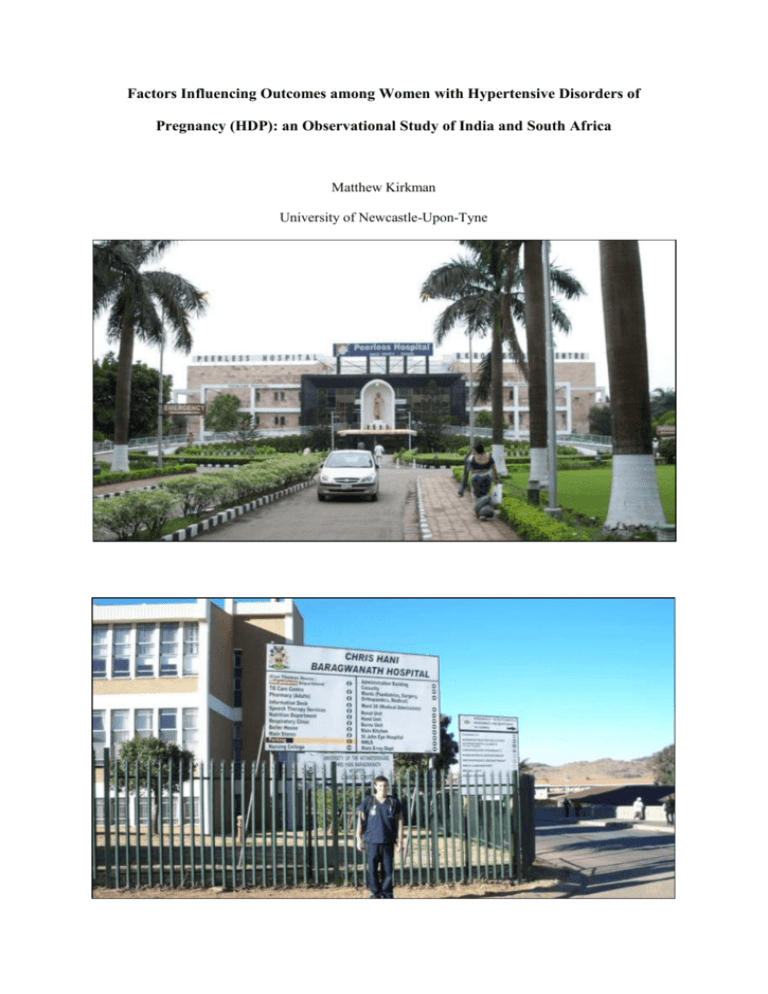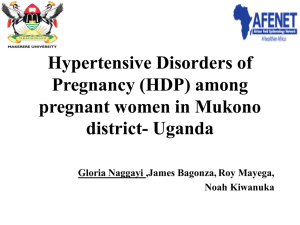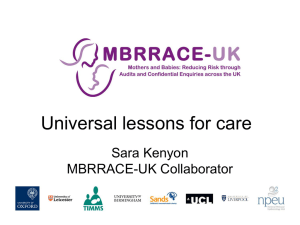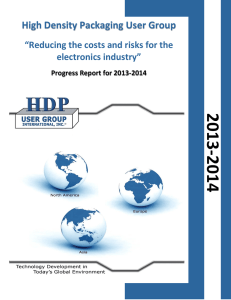Factors Influencing Outcomes among Women with Hypertensive
advertisement

Factors Influencing Outcomes among Women with Hypertensive Disorders of Pregnancy (HDP): an Observational Study of India and South Africa Matthew Kirkman University of Newcastle-Upon-Tyne Introduction In summer 2008 I set off for a once-in-a-lifetime opportunity to experience third world medicine. In the UK, personal clinical experience of the complications of hypertensive disorders of pregnancy (HDP) had left me intrigued as to how they are approached in the developing world. Armed with this interest, I wanted to know more about the different factors that influence health outcomes among women with HDP in India and South Africa. To achieve this aim, I attended Peerless Hospital, Calcutta, India for the month of June and Chris Hani Baragwanath Hospital, Soweto, Johannesburg, South Africa from July to mid-August. The head of the Department of Obstetrics and Gynaecology at Peerless Hospital is Dr. Ghosh, and at Chris Hani Baragwanath Hospital is Prof. Buchmann. At both hospitals, the two months afforded me time in the obstetrics and gynaecology departments, neurology/neurosurgery departments as well as the acute medicine departments, in order to get a broad-based view of the subject matter. Further, in Soweto I visited a local clinic in order to grasp a greater understanding of the journey of a lady throughout pregnancy and beyond. I spoke to doctors, nurses, midwives and, most importantly, the expectant women themselves. Here is a report of my findings, which I hope are as interesting to read as they were to experience and write up. Background It is best to begin by defining exactly what the hypertensive disorders of pregnancy (HDP) are. Common in poor countries, they encompass eclampsia, pre-eclampsia, gestational hypertension and chronic hypertension. Although exact incidence figures are difficult to obtain, one population-based study estimates HDP to have a prevalence of 12% in Durban, South Africa [1]. In India, around 5% of pregnant women screened in a hospital were found to have hypertension. The number of undiagnosed cases, however, is likely to be high. The associated morbidity and mortality for both mother and baby are significant [2], with a high fetal mortality rate and risk of low birth weight babies. Delivery remains the only cure. During medical school I have developed a personal interest in HDP and its complications, specifically the cerebral sequelae which, in South Africa, directly cause over half of all deaths due to hypertensive pregnancies. Research suggests that most deaths associated with HDP could be avoided through both patient and institutional factors [3]. This therefore represents a significant public health issue warranting further study. This project did not concern itself with the risk factors for developing HDP in the first instance, but with the risk factors influencing the outcome of those women with established HDP. With this in mind, I set out about investigating and elucidating on the causes of high mortality rates from HDP in India and South Africa. I conducted an observational qualitative study looking at both patient (e.g. patient education, access to health care) and institutional (e.g. adoption of management guidelines, poor staffing) factors that potentially contribute to high maternal mortality in these countries. India and South Africa Like the UK, India and South Africa have large public-funded health care systems in addition to smaller (but fast-growing) private health care provision. In both countries, primary care and emergency care is offered free by the state, but specialist hi-tech services are invariably restricted to the private sector for the wealthy. Further, state care is poorly-funded, over-utilised and poorlystaffed; the resulting implications for quality of care, morbidity and mortality go without saying. Inequalities in access to care are no more visible than in India and South Africa. Figure 1: A typical street in Calcutta. People wash, eat, sleep, trade and urinate on the streets, and it is the only place in the world where human-pulled rickshaws are still in operation; a sobering sight for even the most hardened of eyes. The culture in India was vastly different to that of South Africa. The culture in India was much more conservative, and the extent to which I could be involved in care as a male was extremely limited; in South Africa this was not so. Calcutta is the third largest city in India with a population exceeding 15 million. Soweto is a working-class black area of approximately two million inhabitants. In India personal safety was not a major concern to me. Soweto, however, is one of the most violent areas of the world, and whilst in the confines of the hospital one feels relatively safe, step outside and it is a different story. The Chris Hani Baragwanath Hospital, or ‘Bara’ as it is affectionately known by the locals, is the largest hospital in the southern hemisphere. The hospital acts as a referral centre for patients with serious problems that could impinge on pregnancy, whilst ‘low-risk’ pregnancies are dealt with by the Soweto Community Health Centres, which provide 24-hour midwife-run maternity services for urban black pregnant women. Dependent on a risk assessment, women can deliver in either the Community Health Centres or in the Hospital. Approximately 15,000 high-risk deliveries are performed at Bara every year. From what I learnt whilst at Bara, very few women deliver in their own homes. Figures on the numbers of deliveries at Peerless Hospital were difficult to obtain, but I became aware that home deliveries were much more common in India than in South Africa. Further, most obstetrics care was provided by hospitals and not community health centres. The Antenatal Clinics at Bara cover different specialties depending on the day – for example, the cardiac clinic was held every Monday. Nurses play a vital role in keeping everything in the department running smoothly. They collect patient information and counsel in small cubicles intended for privacy. Women wait for their urine and blood samples to be taken, to be weighed, have their blood pressure taken or to take part in antenatal exercises. At the same time, nurses provide information to patients on topics as diverse as financial planning, the labour process, nutrition and anaemia. When a woman arrives at Bara whilst in labour, she is taken immediately to the admissions ward, where she is provided with a modest but private cubicle and toilet. The mother’s blood pressure is monitored, along with the foetal heart, four-hourly by the nursing staff. One nurse is given the responsibility of looking after two mothers at a time. At Peerless Hospital the setup of clinics was similar, but the role of patient education was not so prevalent and I felt this had a detrimental effect on patient care there. At my first day at Bara I was met by countless pregnant women waiting patiently on rows of wooden benches. Figure 2 is a picture of the department that registers new arrivals to the hospital (except women in labour and those attending casualty). From here, they are directed to whichever department they need to attend. As one can see, queues were long, and once the patient finally reaches their intended ward, the queues do not end. Figure 2: New arrivals at the Chris Hani Baragwanath Hospital. Figure 3 shows how excess patients were placed along the ends of other patients’ beds. Yet, for all its’ faults, I couldn’t help falling in love with the hospital. The atmosphere at the hospital was unforgettable. I will never forget walking into the ward in the morning to be met by a circle of nurses singing in the most Figure 3: Patients in a female ward waiting for a bed. melodic manner imaginable. Apart from HDP, there are several other notable causes of maternal deaths in South Africa and India. These include direct causes: obstetric haemorrhage, pregnancy-related sepsis, pulmonary embolism, and septic abortion. Indirect causes are also prominent: communicable (HIV/AIDS, TB, malaria) and non-communicable diseases (diabetes and cardiac disease). HIV I could not write this Elective Report without briefly mentioning HIV. It goes without saying that the virus is a big problem in South Africa; over a quarter of all pregnant women in Soweto are thought to be HIV-positive, a rate higher than the rest of the adult population. A patient can have their HIV status results within fifteen minutes and, if positive, can begin counselling and receive treatment immediately. A woman is given a tablet of nevirapine for the onset of labour and, a few hours after being born, the baby is given a bottle of nevirapine syrup. An intensive follow-up programme for both mother and child is adhered to in all HIV-positive mothers. Before the nevirapine treatment became available, around one-quarter of babies born to HIV-positive mothers would also contract the disease, compared to eight percent now. However, one concern among doctors is that taking nevirapine in this fashion will induce resistance to both this drug and other anti-HIV medications when the mother develops full-blown AIDS. Nevertheless, around four out of every five HIV-positive pregnant women at the hospital receive the treatment. In India, the prevalence of HIV is not so alarming, but it is growing rapidly and poor awareness and education is perpetuating the problem. As mentioned earlier in the report, both institutional and individual factors play a part in the outcomes of women with hypertension in pregnancy; these will be discussed in turn, beginning with the institutional factors. Institutional factors Care guidelines have an important role in influencing clinical practice and hence the outcomes of pregnant women. For example, in South Africa the National Department of Health set up the National Committee on Confidential Enquiries into Maternal Deaths (NCCEMD). What resulted in 1998 was “Saving Mothers: Report on Confidential Enquiry into Maternal Deaths in South Africa”, a publication highlighting the alarming maternal mortality ratio and the fact that many deaths are preventable. Policy Guidelines that followed are used by hospitals, community centres and clinics to create institutional guidelines for managing specific emergencies in pregnant women, with the ultimate aim of reducing maternal deaths. Guidelines, however, are of little use unless they are audited and feedback is received so that they can be constantly improved, leading to improvements in clinical practice. Further, national guidelines rarely reflect local working conditions, the actual resources available at the clinician’s disposal, and the individualised nature of patients’ needs. They can often stifle the optimal care of a patient, and I saw numerous occasions when a doctor was convinced that an alternative management plan was more beneficial to the woman and foetus. Guidelines appeared to be more rigorously followed in South Africa than India, and India seemed to rely on guidelines produced by other countries (names the US and UK) for their clinical practice. One problem identified in the “Saving Mothers” document was the poor initial assessment of pregnant women. From my own observations in both South Africa and India, I could see how initial assessments could be rushed in an under-staffed department overflowing with patients. Further, so many patients have complex multi- Figure 4: Woman undergoing assessment in India. system pathology that the assessment process is complex. In pre-eclampsia, the primary pathology originates in the endothelial cells - present throughout the body. Therefore not only are the presentations of such patients multi-systemic, but so is the management and potential complications. In South Africa, the MRC Pregnancy Hypertension Research Unit had developed an international reputation; a key recruiting centre for trials published in the Lancet, it helped make magnesium sulphate the first choice anticonvulsant for the prevention and management of convulsions resulting from HDP. In 2004, however, the unit closed. This is a huge blow to research into HDP for South Africa as well as the rest of the world. As a believer of the importance of medical research in advancing clinical medicine, I feel that this will stifle the development of improved local management guidelines for HDP in the future and therefore impact the outcomes of affected women markedly. India and South Africa are two countries struggling with over-stretched resources. Interventions such as induction of labour, caesarean section, antepartum admission, and neonatal admission, whilst being life-saving interventions and seemingly straightforward, require significant finance as well as skilled health professionals. The discrepancy between supply and demand of ICU beds is large. Communication between health care workers was also suboptimal in some instances. When medical staff were unable to deal with a situations they faced, more senior staff were either not available or not called at all; doctors informed me in India that there were frequently problems in delayed and incorrect referrals, wrong diagnoses, prolonged abnormal observations, and incomplete recognition of all a patient’s problems. The commonest cause of maternal death in HDP in both India and South Africa is intracerebral haemorrhage, and this most likely reflects the lack of importance placed on lowering very high blood pressures. In both India and South Africa, when a critically ill woman presented to primary health care, there was often serious delays in referral to specialised tertiary facilities. Yet these delays were for two reasons – administrative delays and also transport delays. Calcutta and Soweto both have extremely Figure 5: Woman having ultrasound scan in India. poor transport infrastructure. In Calcutta, I narrowly-escaped death whilst crossing the road numerous times and traffic was at a standstill even into the early hours of the morning. In Soweto, public transport is non-existent except for minibus taxis which are fondly referred to by the locals as ‘moving coffins’ because of their notoriously high accident rate. This highlighted to me that problems in transport to the hospital would no doubt be affecting the outcomes of women with acute hypertension. Individual factors The root of many deaths in HDP is poverty, and both Calcutta and Soweto have plenty of it. Poverty means poor access to health care which means delayed presentation to services. In both India and South Africa, there are big problems with attendance at ante-natal services. All pregnant women are offered information on screening. It is well-known that most maternal deaths are attributable to poor attendance of ante-natal clinics. Of those who attend, many present very late, making the identification of complications early in pregnancy difficult and by which point their blood pressure is dangerously high. Further, by presenting late they deny themselves the opportunity to undergo genetic counselling and prenatal diagnosis to exclude chromosomal abnormalities in the fetus. This is in spite of the fact that basic maternity services are free in both countries. One problem that became apparent in both South Africa and India is the increasing group of women becoming pregnant at an older age – a trend reflecting that we observe in the West. These older individuals show a greater incidence of HDP as well as other problems such as gestational diabetes. The problem is, however, that whilst these individuals are more likely to need increased contact with ante-natal services and more obstetric interventions (such as antepartum admission, induction of labour, caesarean section and neonatal admission), and are at increased risk of maternal death, they do not use the ante-natal clinics as much as younger women. The reasons why seem to be multiple, and mainly centre on family and/or work commitments encroaching on personal free time. However, there also seemed to be a ‘practice makes perfect’ attitude prevalent among the older multiparous women and, on occasion, ignorance about the need for antenatal services. It is certainly plausible that such women are the same women who would be hesitant in attending family planning services or submitting themselves for sterilisation, even though they have no plans for further offspring. Although older women are at higher risk of complications during pregnancy, being of older age is not a criterion for hospital delivery as opposed to delivery in a community health centre unless the women is 35 years or older and primigravid. On the opposite end of the scale, a number of patients with eclampsia who die are under the age of twenty; many abscond from antenatal care because their pregnancies are ‘hidden’ for whatever reason. This suggests that information on contraception and termination of pregnancy services should be made more freely available. Poverty also results in poor lifestyle choices. In Calcutta, I was aware of free yoga classes held by the hospital to encourage the reduction in incidence of disorders such as gestational hypertension, on the back of recent evidence from Bangalore, India. This evidence showed regular yoga classes to reduce the likelihood of preterm labour, isolated intrauterine growth retardation, gestational hypertension, and also to improve babies’ birth weight. It was encouraging to see such positive approaches being used to tackle HDP. How do we reduce deaths from HDP? This is an issue of education. All health care professionals attending to pregnant women need to be aware of the risks associated with HDP as well as being able to identify those women at high risk of developing HDP and/or its complications. They should be aware of the different drugs used in the management of acute hypertension. Protocols for the management of hypertension in pregnancy should be known by all staff, not just in hospitals and community health centres, but also by ambulance staff who often spend significant time with patients in transit to tertiary care. However, most importantly of all, the women of India and South Africa need to be educated themselves about the importance of antenatal services to improve clinic attendance. Pregnancy in older women, who are forming a larger subset of the pregnant population, is not only more difficult for both the patient and health care services, it is also more expensive. The HDP are more common in this group. Education is vital in raising awareness of the different methods of contraception available and the risks of pregnancy in advancing age. Those not wishing to have further children should be counselled during ante-natal visits about the safe and cost-effective nature of sterilisation, and any myths or misconceptions about the procedure can also be laid to rest at this time. This is also an issue of resources. Magnesium sulphate should be widely available at all antenatal clinic locations, and emergency services staff should be educated in how exactly to administer it. The infrastructure of the health service at the local level should allow the proper referral and transport of patients to the correct destination, and details of this should be known by all relevant health care staff. More ICU facilities are required to deal with this complicated set of diseases. Yet perhaps with better education about recognising HDP we can prevent the need for more ICU beds in the first instance. I wonder how possible all of these interventions are in two countries with severe shortcomings in infrastructure and resources. However, it needs to be ensured that all pregnant women get the antenatal care that they deserve – surely a basic human right? Reflections on the experience My elective experience was truly unforgettable. It afforded me time in numerous different clinical settings, and visiting the clinics and the local community health centres were just as enjoyable as the time spent in wards, theatre, and the delivery suite. Witnessing medicine in the third world afforded me a unique perspective upon health care which has enriched my experiences whilst an undergraduate. The extent to which I was involved with patient care was much greater than what would be allowed back in the UK, and I saw this as an opportunity to benefit the people of Calcutta and Soweto, as well as my own clinical skills and the patients that I will care for in my future career. Being given high levels of responsibility (especially in South Africa) has helped me develop my history-taking, examination, diagnostic and management skills far more than I ever imagined possible. I feel more confident in approaching the obstetrics and gynaecology rotation of the final year of medical school, and indeed the specialty more generally in my future career. This elective experience has really cemented my desire to go into obstetrics and to combine a clinical career with academic research. I believe my report has identified the importance of education and resources in tackling HDP and, whilst there is no immediate solution to any of the problems identified in India and South Africa, I strongly believe that advances are being made and the future is positive for both countries. Acknowledgments First of all, I would like to thank all the patients and health professionals I spoke to whilst on my elective. Without them, nothing would have materialised from this project. In addition, I would like to thank Wellbeing of Women and the Barbour Trust for providing financial assistance for my elective because without their financial assistance there is no doubt that I would not have been able to have gained such fond memories which I will cherish for the rest of my life. References 1. Panday M, Mantel GD, Moodley J. Audit of severe acute morbidity in hypertensive pregnancies in a developing country. J Obstet Gynaecol 2004; 24(4):387-91. 2. Moodley J, Rout CC. Maternal deaths associated with hypertensive disorders of pregnancy. S Afr Med J (Obstet Gynaecol) 1997; 87(6):793–798. 3. Moodley J. Maternal Deaths Associated with Hypertensive Disorders of Pregnancy: a Population-Based Study. Hypertension in Pregnancy 2005; 23(3):247–256.










